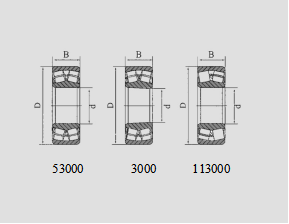
9 月 . 22, 2024 18:41 Back to list
angular contact ball bearing
Understanding Angular Contact Ball Bearings
Angular contact ball bearings are a specialized type of rolling element bearing designed to accommodate axial loads in addition to radial loads. Unlike conventional radial ball bearings, angular contact ball bearings are engineered with a specific angle between the line of action of the load and the axis of the bearing. This unique design enables them to support higher speeds and handle combined loads more effectively, making them an essential component in various mechanical applications.
The primary feature of angular contact ball bearings is the contact angle, which is the angle between the radial line and the line of action of the load. This angle can vary based on the design and application, typically ranging from 15 to 40 degrees. A larger contact angle allows the bearing to carry higher axial loads. Consequently, these bearings are commonly found in applications where strict reliability and performance standards must be met, such as in machine tools, automotive gearboxes, and high-speed spindles.
Angular contact ball bearings can be configured in different arrangements, including single-row, double-row, and even four-point contact bearings. Single-row bearings are designed for applications that experience moderate axial loads, while double-row designs can handle higher loads and provide greater rigidity. The four-point contact design further enhances load capacity and is often used in applications requiring precise axial positioning.
angular contact ball bearing

Installation and maintenance of angular contact ball bearings require careful attention. The bearings need to be properly preloaded to remove any play and ensure accurate alignment. Preloading can be achieved through various methods, such as applying a measured axial load or using specific spacer designs. Proper lubrication is also crucial in minimizing friction and wear, typically achieved with grease or oil. Regular inspection and maintenance will further prolong the life of these bearings, ensuring optimal performance in their intended applications.
In terms of materials, high-quality steel is often used in the manufacturing of angular contact ball bearings to enhance durability and strength. Advanced materials, such as ceramic balls or hybrid combinations of ceramic and steel, are increasingly popular due to their lightweight and superior resistance to fatigue and thermal stress. These innovations contribute to the ongoing development of angular contact ball bearings, making them suitable for high-performance applications.
Overall, angular contact ball bearings are a vital component in the engineering and manufacturing sectors, providing support in a wide range of machines and devices. Their ability to handle combined loads, high speeds, and offer precision positioning makes them indispensable in modern machinery. As industries continue to evolve, the demand for reliable and efficient bearing solutions will only increase, solidifying the role of angular contact ball bearings in future technological advancements. Whether in aerospace, automotive, or industrial machinery, understanding and utilizing these advanced bearing systems is integral to achieving high performance and operational efficiency.
Latest news
-
Unlocking Efficiency with Spherical Roller Bearings
NewsOct.29,2024
-
The Ultimate Guide to Thrust Ball Bearings
NewsOct.29,2024
-
The Power of Thrust Roller Bearings: Engineered for Excellence
NewsOct.29,2024
-
The Power of Deep Groove Ball Bearings for Your Application Needs!
NewsOct.29,2024
-
The Power and Performance of Cylindrical Roller Bearings
NewsOct.29,2024
-
High-Quality Ball Bearing Manufacturing Machines
NewsOct.29,2024
